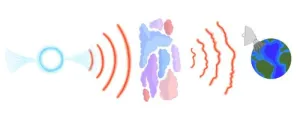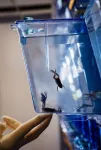(Press-News.org) Team Unlocks New Insights on Pulsar Signals
November 26, 2024, Mountain View, CA – Dr. Sofia Sheikh from the SETI Institute led a study that sheds new light on how pulsar signals—the spinning remnants of massive stars—distort as they travel through space. This study, published in The Astrophysical Journal, was performed by a multi-year cohort of undergraduate researchers in the Penn State branch of the Pulsar Search Collaboratory student club. Maura McLaughlin, Chair, Eberly Distinguished Professor of Physics and Astronomy, West Virginia University, created the Pulsar Search Collaboratory to engage high schoolers and undergraduates in pulsar science, and she helped facilitate access to the data used in this study. Using archival data from the Arecibo Observatory, the student team found patterns that show how pulsar signals change as they move through the interstellar medium (ISM), the gas and dust that fills the space between stars. The team measured scintillation bandwidths for 23 pulsars, including new data for six pulsars not previously studied. The results showed that in almost all cases, measured bandwidths were higher than predictions by widely used models of the galaxy, highlighting a need for updates to current ISM density models.
“This work demonstrates the value of large, archived datasets,” said Dr. Sofia Sheikh, SETI Institute researcher and lead author. “Even years after the Arecibo Observatory's collapse, its data continues to unlock critical information that can advance our understanding of the galaxy and enhance our ability to study phenomena like gravitational waves.”
When radio light from a pulsar travels through the ISM, it gets distorted in a process known as "diffractive interstellar scintillation” (DISS). The same physics that makes light refract into patterns on the bottom of a swimming pool or causes stars to twinkle in the night sky also causes DISS. Instead of water in a pool or air in the atmosphere, DISS occurs when clouds of charged particles in space cause a pulsar's light to "twinkle" across time and frequency.
Collaborations such as the NANOGrav Physics Frontiers Center use pulsars to study the gravitational wave background, which can help researchers understand the early Universe and the prevalence of gravitational-wave sources such as supermassive black-hole binaries. The pulsar timing measurements must be extremely precise to measure the gravitational wave background correctly. The results from this study will help better model the distortions caused by DISS, which will increase the precision of the pulsar timing measurements of projects like NANOGrav.
The study found that models incorporating galactic structures, such as spiral arms, tend to better fit the DISS data despite the challenge of accurately modeling the Milky Way’s structure. Moreover, the study showed that the models most accurately predicted the bandwidths of pulsars that were used in their development while predictions of newly discovered pulsars were worse. This suggests limitations that reinforce the need for continual updates to galactic structure models."
This pilot study, part of the AO327 survey from Arecibo, serves as a foundation for future research on pulsar scintillation and gravitational waves. By expanding the pilot study to more recently discovered pulsars in the AO327 dataset in the future, the team hopes to further improve ISM density models for collaborations that observe pulsar timing arrays like NANOGrav.
This research involves the collaboration between authors at the SETI Institute, Penn State, and the NANOGrav Group at West Virginia University. The team includes SETI Institute researcher Michael Lam and former SETI Institute researcher Grayce Brown.
Read the paper here: https://iopscience.iop.org/article/10.3847/1538-4357/ad8659. DOI: 10.3847/1538-4357/ad8659.
About the SETI Institute
Founded in 1984, the SETI Institute is a non-profit, multi-disciplinary research and education organization whose mission is to lead humanity’s quest to understand the origins and prevalence of life and intelligence in the universe and share that knowledge with the world. Our research encompasses the physical and biological sciences and leverages data analytics, machine learning, and advanced signal detection technologies. The SETI Institute is a distinguished research partner for industry, academia, and government agencies, including NASA and the National Science Foundation.
Contact information
Rebecca McDonald
Director of Communications
SETI Institute
rmcdonald@seti.org
END
Team unlocks new insights on pulsar signals
Results showed that in almost all cases, measured bandwidths were higher than predictions by widely used models of the galaxy, highlighting a need for updates to current ISM density models.
2024-11-26
ELSE PRESS RELEASES FROM THIS DATE:
Great apes visually track subject-object relationships like humans do
2024-11-26
Great apes track events with their eyes in the same way that humans do, according to a study published November 26th in the open-access journal PLOS Biology by Vanessa Wilson from the University of Neuchatel, Switzerland, and colleagues.
When watching a cat chase a mouse, humans will alternate looking at cat and mouse, using the information to connect the two into what’s called an agent-patient relationship—with the cat as the agent and the mouse as the patient. This cognitive mechanism is thought to be ...
Recovery of testing for heart disease risk factors post-COVID remains patchy
2024-11-26
Routine screening to detect risk factors for heart disease dropped sharply during the COVID-19 pandemic in England, and some key measurements, such as blood pressure readings, may still lag behind pre-pandemic levels. These findings are reported in a new study by Frederick Ho and Naveed Sattar of the University of Glasgow, Scotland, UK, and colleagues published November 26th in the open-access journal PLOS Medicine.
During the COVID-19 pandemic, patients went without routine face-to-face health checks, which are important for detecting common cardiometabolic ...
Final data and undiscovered images from NASA’s NEOWISE
2024-11-26
While NASA’s NEOWISE telescope ended its journey through space on Nov. 1, 2024, the team at IPAC, a science center at Caltech, was working on one further gift from the prolific mission.
The final data release from NEOWISE was released to the astronomy community just two weeks later, on Nov. 14, encompassing over 26 million images and nearly 200 billion sources detected by the telescope. And today, IPAC is releasing six new images from the mission’s archival data as a tribute to this landmark project, available here: https://www.astropix.org/link/3b2x
NEOWISE ...
Nucleoporin93: A silent protector in vascular health
2024-11-26
"Research in the last several decades has established endothelial cells (ECs) as a dynamic interface critical for vascular protection.”
BUFFALO, NY- November 26, 2024 – This editorial was published by Aging (listed by MEDLINE/PubMed as "Aging (Albany NY)" and "Aging-US" by Web of Science) in Volume 16, Issue 17, titled, “The silent protector: Nucleoporin93’s role in vascular health.”
Written by Julia Michalkiewicz, Tung D. Nguyen, and Monica Y. Lee from The University of Illinois at Chicago College of Medicine, ...
Can we avert the looming food crisis of climate change?
2024-11-26
WASHINGTON, Nov. 26, 2024 – Human activities are causing atmospheric carbon dioxide (CO2) levels to rise, which increases the global average surface temperature—and poses a threat to crop growth. Escalating concerns about climate change’s impact on global food security inspired researchers from Banaras Hindu University in India to create a way to explore how these factors influence crop yields.
In Chaos, from AIP Publishing, the researchers share a mathematical model created to capture the nonlinear relationships between CO2, temperature, human population, ...
Alcohol use and antiobesity medication treatment
2024-11-26
About The Study: This cohort study among individuals participating in a weight loss program found that nearly half of those consuming alcohol at baseline decreased their alcohol use after anti-obesity medication initiation. There may be properties of anti-obesity medications that lead to reduced use. For example, naltrexone decreases cravings for alcohol and glucagon-like peptide-1 receptor agonists (GLP-1 RAs) may attenuate the rewarding effects of alcohol, similar to food.
Corresponding Author: To contact the corresponding author, Lisa R. Miller-Matero, PhD, email lmatero1@hfhs.org.
To access the embargoed study: Visit our For The Media website at ...
Study reveals cause of common cancer immunotherapy side effect
2024-11-26
A multinational collaboration co-led by the Garvan Institute of Medical Research has uncovered a potential explanation for why some cancer patients receiving a type of immunotherapy called checkpoint inhibitors experience increased susceptibility to common infections.
The findings, published in the journal Immunity, provide new insights into immune responses and reveal a potential approach to preventing the common cancer therapy side effect.
“Immune checkpoint inhibitor therapies have revolutionised cancer treatment ...
New era in amphibian biology
2024-11-26
Amphibians hold a significant place in evolution, representing the transition from aquatic to terrestrial lifestyles. They are crucial for understanding the brain and spinal cord of tetrapods—animals with four limbs, including humans. A group of scientists led by a team at the Institute of Science and Technology Austria (ISTA) now shows how harmless viruses can be used to illuminate the development of the frog nervous system. The results have now been published in Developmental Cell.
Virus. When you hear the word, you probably shudder. But not all viruses are bad or cause disease. Some are even used for therapeutic ...
Harbor service, VAST Data provide boost for NCSA systems
2024-11-26
The National Center for Supercomputing Applications and VAST Data are giving supercomputing system Delta and the newly launched DeltaAI a boost in their storage and application performance.
NCSA launched Harbor, a service that provides very fast storage for global home and software directories across all NCSA open-science resources. Its deployment has led to a 400% increase in application launch performance for the Delta system, among many other gains.
Over the last two years, we’ve seen a significant increase in ...
New prognostic model enhances survival prediction in liver failure
2024-11-26
Researchers have unveiled a groundbreaking advancement in liver failure care: the CATCH-LIFE-MELD score (Chinese Acute-on-Chronic Liver Failure Consortium (CATCH-LIFE)-MELD score). This innovative tool, developed by an international team led by Xia Yu and colleagues, enhances the accuracy of predicting short-term survival outcomes for patients suffering from acute-on-chronic liver failure (ACLF). The study, published in eGastroenterology, promises to revolutionize patient management and treatment planning for this life-threatening condition.
“ACLF presents unique challenges due to its rapid progression and high mortality rates,” said Dr. Yu Shi, senior researcher at Zhejiang University ...
LAST 30 PRESS RELEASES:
Tracing the quick synthesis of an industrially important catalyst
New software sheds light on cancer’s hidden genetic networks
UT Health San Antonio awarded $3 million in CPRIT grants to bolster cancer research and prevention efforts in South Texas
Third symposium spotlights global challenge of new contaminants in China’s fight against pollution
From straw to soil harmony: International team reveals how biochar supercharges carbon-smart farming
Myeloma: How AI is redrawing the map of cancer care
Manhattan E. Charurat, Ph.D., MHS invested as the Homer and Martha Gudelsky Distinguished Professor in Medicine at the University of Maryland School of Medicine
Insilico Medicine’s Pharma.AI Q4 Winter Launch Recap: Revolutionizing drug discovery with cutting-edge AI innovations, accelerating the path to pharmaceutical superintelligence
Nanoplastics have diet-dependent impacts on digestive system health
Brain neuron death occurs throughout life and increases with age, a natural human protein drug may halt neuron death in Alzheimer’s disease
SPIE and CLP announce the recipients of the 2025 Advanced Photonics Young Innovator Award
Lessons from the Caldor Fire’s Christmas Valley ‘Miracle’
Ant societies rose by trading individual protection for collective power
Research reveals how ancient viral DNA shapes early embryonic development
A molecular gatekeeper that controls protein synthesis
New ‘cloaking device’ concept to shield sensitive tech from magnetic fields
Researchers show impact of mountain building and climate change on alpine biodiversity
Study models the transition from Neanderthals to modern humans in Europe
University of Phoenix College of Doctoral Studies releases white paper on AI-driven skilling to reduce burnout and restore worker autonomy
AIs fail at the game of visual “telephone”
The levers for a sustainable food system
Potential changes in US homelessness by ending federal support for housing first programs
Vulnerability of large language models to prompt injection when providing medical advice
Researchers develop new system for high-energy-density, long-life, multi-electron transfer bromine-based flow batteries
Ending federal support for housing first programs could increase U.S. homelessness by 5% in one year, new JAMA study finds
New research uncovers molecular ‘safety switch’ shielding cancers from immune attack
Bacteria resisting viral infection can still sink carbon to ocean floor
Younger biological age may increase depression risk in older women during COVID-19
Bharat Innovates 2026 National Basecamp Showcases India’s Most Promising Deep-Tech Ventures
Here’s what determines whether your income level rises or falls
[Press-News.org] Team unlocks new insights on pulsar signalsResults showed that in almost all cases, measured bandwidths were higher than predictions by widely used models of the galaxy, highlighting a need for updates to current ISM density models.








